Timeline Views in WinUI Scheduler (SfScheduler)
13 Jun 202424 minutes to read
The TimelineView displays the dates in the horizontal time axis with the desired day’s count. Scheduler supports displaying the TimelineDay, TimelineWeek, TimelineWorkWeek, and TimelineMonth views. See the past or future dates by scrolling to the right or left. Each view displays the events accurately across the time slots with an intuitive drag-and-drop feature. It provides the support to highlight the selected region of time slots and handle the interaction.
Change time interval
Customize the interval of timeslots in the timeline views by using the TimeInterval property of TimelineViewSettings. This property will be applicable to TimelineDay, TimelineWeek, and TimelineWorkWeek views.
<scheduler:SfScheduler x:Name="Schedule"
ViewType="TimelineWeek" >
</scheduler:SfScheduler>this.Schedule.ViewType = SchedulerViewType.TimelineWeek;
this.Schedule.TimelineViewSettings.TimeInterval = new System.TimeSpan(0, 120, 0);
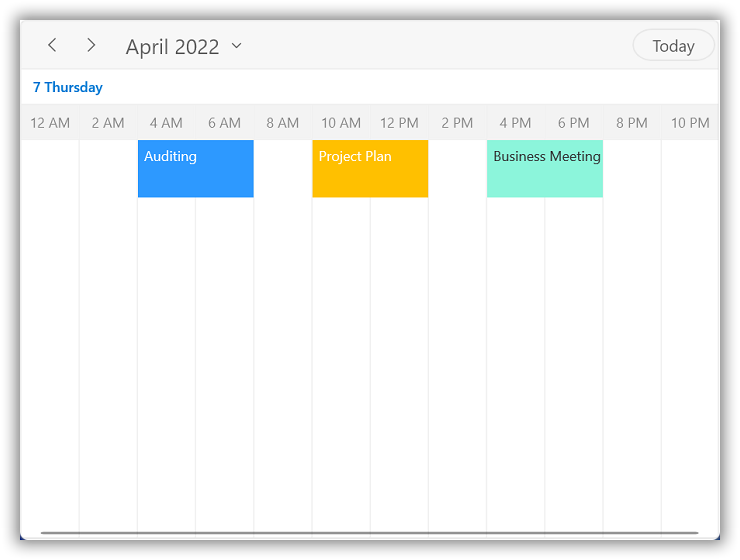
NOTE
If the timeInterval value is modified (in minutes), change the time labels format by setting the timeFormat value to hh:mm.
Change time interval width
Customize the interval width of timeslots in the Timeline views by setting the TimeIntervalSize property of TimelineViewSettings. This property will be applicable to all timeline views. By default, it’s value is 50 for the TimelineDay, TimelineWeek, and TimelineWorkWeek views and 150 for TimelineMonth view.
<scheduler:SfScheduler x:Name="Schedule" ViewType="TimelineWeek">
<scheduler:SfScheduler.TimelineViewSettings>
<scheduler:TimelineViewSettings
TimeIntervalSize="120"/>
</scheduler:SfScheduler.TimelineViewSettings>
</scheduler:SfScheduler>this.Schedule.ViewType = SchedulerViewType.TimelineWeek;
this.Schedule.TimelineViewSettings.TimeIntervalSize = 120;

Flexible working days
By default, the WinUI Scheduler considers the week days from Monday to Friday as Working days. The days which are defined in this non-working days collection are considered as non-working days. Therefore, when the weekend days are set to hide from Scheduler.
The Timeline workweek view displays exactly the defined working days on Scheduler control, whereas other views displays all the days.
<scheduler:SfScheduler x:Name="Schedule" ViewType="TimelineWeek">
<scheduler:SfScheduler.TimelineViewSettings>
<scheduler:TimelineViewSettings
NonWorkingDays="Monday,Tuesday"/>
</scheduler:SfScheduler.TimelineViewSettings>
</scheduler:SfScheduler>this.Schedule.ViewType = SchedulerViewType.TimelineWorkWeek;
this.Schedule.TimelineViewSettings.NonWorkingDays = new ObservableCollection<DayOfWeek>() { DayOfWeek.Monday, DayOfWeek.Tuesday };
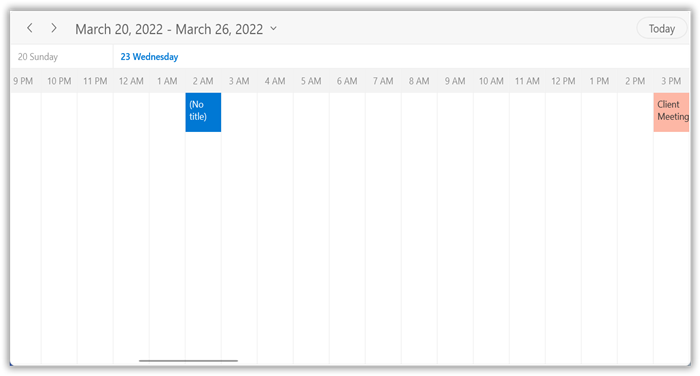
Flexible working hours
The default values for the StartHour and EndHour are 0 and 24 to show all the time slots in a timeline view. Set the StartHour and EndHour properties of TimelineViewSettings to show only the required time duration for users. Set the StartHour and EndHour in time duration to show the required time duration in minutes. The StartHour and EndHour properties do not apply to the TimelineMonth view.
<scheduler:SfScheduler x:Name="Schedule" ViewType="TimelineWeek">
<scheduler:SfScheduler.TimelineViewSettings>
<scheduler:TimelineViewSettings
StartHour="8"
EndHour="13"/>
</scheduler:SfScheduler.TimelineViewSettings>
</scheduler:SfScheduler>this.Schedule.ViewType = SchedulerViewType.TimelineWeek;
this.Schedule.TimelineViewSettings.StartHour = 8;
this.Schedule.TimelineViewSettings.EndHour = 16;
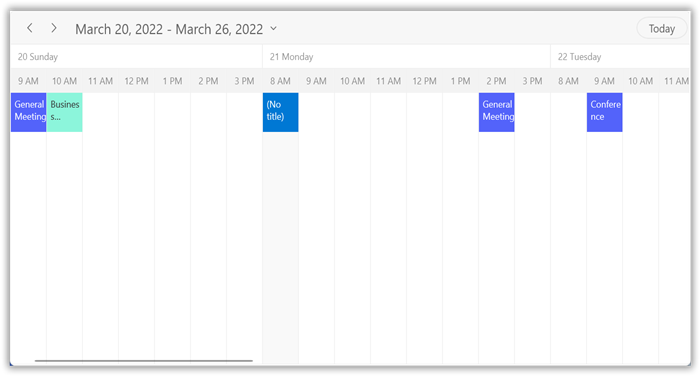
NOTE
- The NonWorkingDays property will be applicable only for
workWeekandTimelineWorkWeekviews only, and not applicable for the remaining views.- The Scheduler Appointments UI, which does not fall within the
StartHourandEndHourwill not be visible and if it falls partially, it will be clipped.- No need to specify the decimal point values for
StartHourandEndHourif you do not want to set the minutes.- The number of time slots will be calculated based on total minutes of a day and time interval (total minutes of a day ((start hour - end hour) * 60) / time interval).
If the custom timeInterval is given, then the number of time slots calculated based on the givenTimeIntervalshould result in an integer value (total minutes % timeInterval = 0). Otherwise, the next immediate time interval that results in integer value when dividing total minutes of a day will be considered. For example, if TimeInterval= 2 Hours, 15 minutes and total minutes = 1440 (24 Hours per day), then theTimeIntervalwill be changed to ‘144’ (1440%144=0) by considering (total minutes % TimeInterval = 0), it will return integer value for time slots rendering.- If the custom
StartHourandEndHourare given, then the number of time slots calculated based on givenStartHourandEndHourshould result in integer value, otherwise next immediateTimeIntervalwill be considered until the result is integer value. For example, if StartHour is 9 (09:00AM), EndHour is 18.25 (06:15 PM), TimeInterval is 30 minutes, and total minutes = 555 ((18.25-9)*60), then the TimeInterval will be changed to ’37 minutes’ (555%37=0) by considering (total minutes % timeInterval = 0). It will return integer value for time slots rendering.
Change days count
Change the day’s count of timeslots in the timeline view by setting the DaysCount property of TimelineViewSettings. This property is only applicable for the TimelineDay view. By default, its value is set to 1.
<scheduler:SfScheduler x:Name="Schedule" ItemsSource="{Binding Appointments}" ViewType="TimelineDay">
<scheduler:SfScheduler.TimelineViewSettings>
<scheduler:TimelineViewSettings
DaysCount="2"/>
</scheduler:SfScheduler.TimelineViewSettings>
</scheduler:SfScheduler>this.Schedule.ViewType = SchedulerViewType.TimelineDay;
this.Schedule.TimelineViewSettings.DaysCount = 2;
Blackout dates
Disable the interaction for certain dates in the scheduler TimelineMonth view by adding those specific dates to the BlackoutDates collection property of SfScheduler. Using this, allocate or restrict the specific dates for predefined events. This property does not apply to the TimelineDay, TimelineWeek, and TimelineWorkWeek views.
<scheduler:SfScheduler x:Name="Schedule" ViewType="TimelineMonth">
</scheduler:SfScheduler>this.Schedule.ViewType = SchedulerViewType.TimelineMonth;
this.Schedule.BlackoutDates = GetBlackoutDates();
/// <summary>
/// Method to get all blackout date collections.
/// </summary>
private ObservableCollection<DateTime> GetBlackoutDates()
{
var blackoutDateCollection = new ObservableCollection<DateTime>()
{
DateTime.Now.Date.AddDays(-1),
DateTime.Now.Date.AddDays(-3),
DateTime.Now.Date.AddDays(-4),
DateTime.Now.Date.AddDays(1),
DateTime.Now.Date.AddDays(3),
DateTime.Now.Date.AddDays(5)
};
return blackoutDateCollection;
}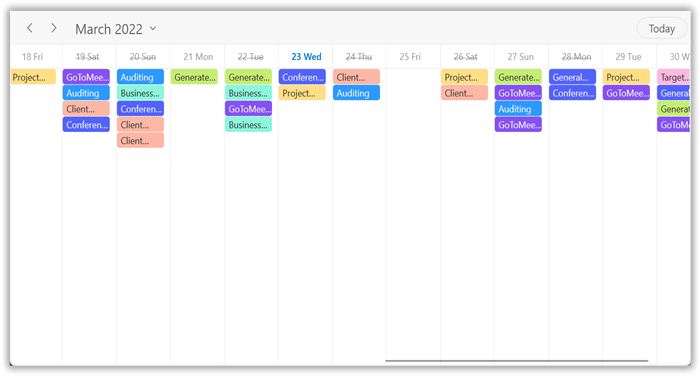
Special time regions
Restrict the user interaction such as selection and highlights specific regions of time in the timeline views by adding the SpecialTimeRegions property of SfScheduler. Set the StartTime and EndTime properties of SpecialTimeRegion to create a SpecialTimeRegion, use the timeZone property to set the specific timezone for the start and end time of the SpecialTimeRegion. The SpecialTimeRegion will display the text or image on it that set to the text or icon property of SpecialTimeRegion. This property will be applicable to the TimelineDay, TimelineWeek, and TimelineWorkWeek views.
Selection restriction in timeslots
Enable or disable the touch interaction of SpecialTimeRegion using the CanEdit property of SpecialTimeRegion. By default, its value is set to true.
<scheduler:SfScheduler x:Name="Schedule"
ViewType="TimelineWeek" >
</scheduler:SfScheduler>this.Schedule.ViewType = SchedulerViewType.TimelineWeek;
this.Schedule.TimelineViewSettings.SpecialTimeRegions.Add(new SpecialTimeRegion
{
StartTime = new System.DateTime(2021, 03, 26, 13, 0, 0),
EndTime = new System.DateTime(2021, 03, 26, 14, 0, 0),
Text = "Lunch",
CanEdit = false,
Background = new SolidColorBrush(Colors.LightGray),
Foreground = new SolidColorBrush(Colors.White)
});
NOTE
This property only restricts the interaction on region and it does not restrict the following:
- Programmatic selection (if the user updates the selected date value dynamically).
- Does not clear the selection when the user selects the region and dynamically changes the CanEdit property to false.
- It does not restrict the appointment interaction when the appointment is placed in the region.
- It does not restrict the appointment rendering on a region when the appointments are loaded from data services or adding programmatically.
Recurring time region
The recurring time region on a daily, weekly, monthly, or yearly interval. The recurring special time regions can be created by setting the RecurrenceRule property in SpecialTimeRegion.
<scheduler:SfScheduler x:Name="Schedule"
ViewType="TimelineWeek" >
</scheduler:SfScheduler>this.Schedule.ViewType = SchedulerViewType.TimelineWeek;
this.Schedule.TimelineViewSettings.SpecialTimeRegions.Add(new SpecialTimeRegion
{
StartTime = new System.DateTime(2021, 03, 21, 13, 0, 0),
EndTime = new System.DateTime(2021, 03, 21, 14, 0, 0),
Text = "Lunch",
CanEdit = false,
Background = new SolidColorBrush(Colors.LightGray),
Foreground = new SolidColorBrush(Colors.White),
RecurrenceRule = "FREQ=DAILY;INTERVAL=1"
});Recurrence exception dates
Delete any of occurrence that is an exception from the recurrence pattern time region by using the RecurrenceExceptionDates property of SpecialTimeRegion. The deleted occurrence date will be considered as a recurrence exception date.
<scheduler:SfScheduler x:Name="Schedule"
ViewType="TimelineWeek" >
</scheduler:SfScheduler>this.Schedule.ViewType = SchedulerViewType.TimelineWeek;
DateTime recurrenceExceptionDates = DateTime.Now.Date.AddDays(-1);
DateTime recurrenceExceptionDates1 = DateTime.Now.Date.AddDays(2);
this.Schedule.TimelineViewSettings.SpecialTimeRegions.Add(new SpecialTimeRegion
{
StartTime = new System.DateTime(2021, 03, 26, 12, 0, 0),
EndTime = new System.DateTime(2020, 03, 26, 13, 0, 0),
Text = "Lunch",
CanEdit = false,
Background = new SolidColorBrush(Colors.LightGray),
Foreground = new SolidColorBrush(Colors.White),
RecurrenceRule = "FREQ=DAILY;INTERVAL=1",
RecurrenceExceptionDates = new ObservableCollection<DateTime>()
{
recurrenceExceptionDates,
recurrenceExceptionDates1,
}
});Special time region customization
The SpecialTimeRegion background color can be customized by using the Background and SpecialTimeRegionTemplate properties of SpecialTimeRegion that is used to customize the text style for the image of the SpecialTimeRegion.
<Grid>
<Grid.Resources>
<DataTemplate x:Key="specialRegionTemplate">
<Grid Background="{Binding Background}"
Opacity="0.5"
HorizontalAlignment="Stretch"
VerticalAlignment="Stretch">
<Path x:Name="Fork" Data="M11,0 C11.553001,0 12,0.4469986 12,1 L12,15 C12,15.553001 11.553001,16 11,16 10.446999,16 10,15.553001 10,15 L10,7 9,7 C8.4469986,7 8,6.5530014 8,6 L8,3 C8,1.3429985 9.3429985,0 11,0 z M0,0 L1,0 1.2340002,4 1.7810001,4 2,0 3,0 3.2340002,4 3.7810001,4 4,0 5,0 5,4 C5,4.9660001 4.3140001,5.7727499 3.4029064,5.9593439 L3.4007993,5.9597201 3.9114671,14.517 C3.9594617,15.321 3.3195295,16 2.5136147,16 L2.5076156,16 C1.6937013,16 1.0517693,15.309 1.1107631,14.497 L1.7400641,5.9826035 1.6955509,5.9769421 C0.73587513,5.8301721 0,5.0005002 0,4 z" Fill="Black" HorizontalAlignment="Center" Height="16" Stretch="Fill" VerticalAlignment="Center" Width="12"/>
</Grid>
</DataTemplate>
</Grid.Resources>
<scheduler:SfScheduler x:Name="Schedule" ViewType="TimelineWeek">
<scheduler:SfScheduler.TimelineViewSettings>
<scheduler:TimelineViewSettings
SpecialTimeRegionTemplate="{StaticResource specialRegionTemplate}">
</scheduler:TimelineViewSettings>
</scheduler:SfScheduler.TimelineViewSettings>
</scheduler:SfScheduler>
</Grid>this.Schedule.TimelineViewSettings.SpecialTimeRegions.Add(new SpecialTimeRegion
{
StartTime = new System.DateTime(2021, 03, 21, 13, 0, 0),
EndTime = new System.DateTime(2021, 03, 21, 14, 0, 0),
Text = "Lunch",
CanEdit = false,
RecurrenceRule = "FREQ=DAILY;INTERVAL=1",
CanMergeAdjacentRegions = true,
Background = new SolidColorBrush(Colors.LightGray),
Foreground = new SolidColorBrush(Colors.White),
});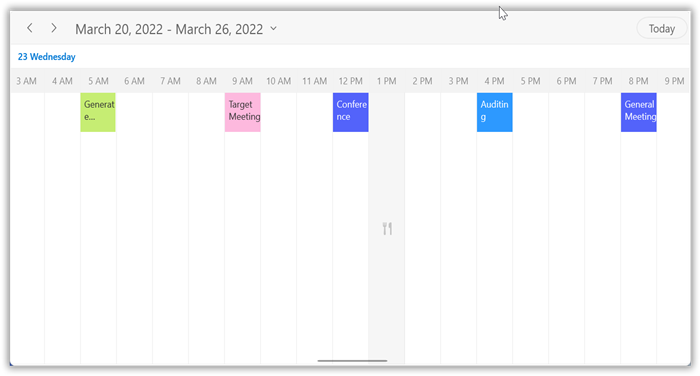
NOTE
Full screen scheduler
The WinUI scheduler time interval width can be adjusted based on the screen height by changing the value of TimeIntervalSize property to -1. It will auto-fit to the screen width in timeline day, timeline week and timeline workweek views.
<scheduler:SfScheduler x:Name="Schedule" ViewType="TimelineWeek">
<scheduler:SfScheduler.TimelineViewSettings>
<scheduler:TimelineViewSettings
TimeIntervalSize="-1"/>
</scheduler:SfScheduler.TimelineViewSettings>
</scheduler:SfScheduler>this.Schedule.ViewType = SchedulerViewType.TimelineWeek;
this.Schedule.TimelineViewSettings.TimeIntervalSize = -1;
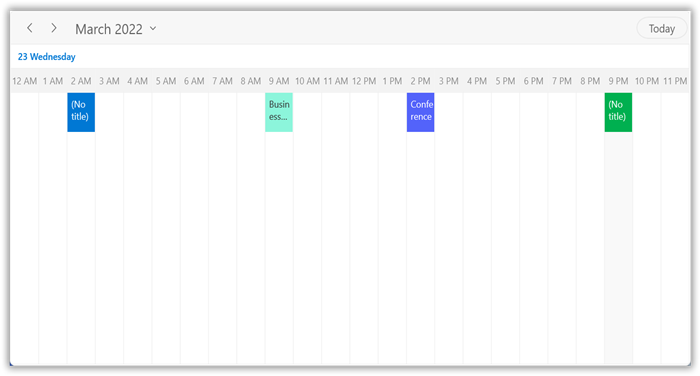
Change time ruler size
Customize the size of the time ruler view where the labels mentioning the time are placed by using the TimeRulerSize property of TimelineViewSettings. This property will be applicable to TimelineDay, TimelineWeek, and TimelineWorkWeek views.
<scheduler:SfScheduler x:Name="Schedule" ViewType="TimelineWeek">
<scheduler:SfScheduler.TimelineViewSettings>
<scheduler:TimelineViewSettings
TimeRulerSize="100">
</scheduler:TimelineViewSettings>
</scheduler:SfScheduler.TimelineViewSettings>
</scheduler:SfScheduler>this.Schedule.ViewType = SchedulerViewType.TimelineWeek;
this.Schedule.TimelineViewSettings.TimeRulerSize = 100;
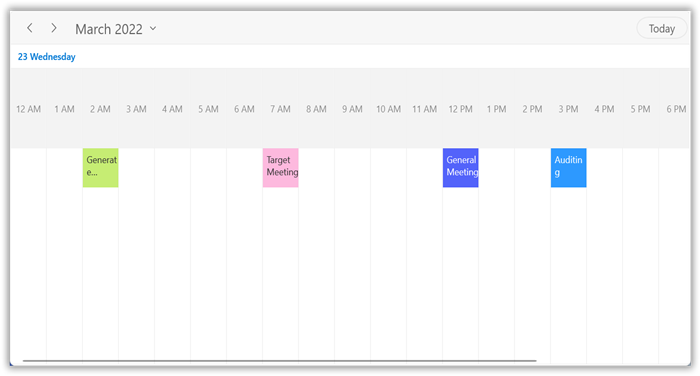
Minimum appointment duration
The MinimumAppointmentDuration property in the TimelineViewSettings is to set an arbitrary height to appointments when it has a minimum duration in timeline view so that the subject can be readable. This property will not apply to the TimelineMonth view.
<scheduler:SfScheduler x:Name="Schedule"
ViewType="TimelineWeek" >
</scheduler:SfScheduler>this.Schedule.ViewType = SchedulerViewType.TimelineWeek;
this.Schedule.TimelineViewSettings.MinimumAppointmentDuration = new System.TimeSpan(0, 120, 0);
NOTE
- The
MinimumAppointmentDurationvalue will be set when an appointment duration value is lesser thanMinimumAppointmentDuration.- Appointment duration value will be set when the appointment duration value is greater than
MinimumAppointmentDuration.- The
TimeIntervalvalue will be set when theMinimumAppointmentDurationis greater thanTimeIntervalwith lesser appointment duration.- All-day Appointment does not support
MinimumAppointmentDuration.
Time ruler text formatting
Customize the format for the labels mentioning the time by setting the TimeRulerFormat property of TimelineViewSettings in the Scheduler. This property will not apply to the TimelineMonth view.
<scheduler:SfScheduler x:Name="Schedule"
ViewType="TimelineWeek" >
</scheduler:SfScheduler>this.Schedule.ViewType = SchedulerViewType.TimelineWeek;
this.Schedule.TimelineViewSettings.TimeRulerFormat = "hh mm";
this.Schedule.TimelineViewSettings.TimeInterval = new System.TimeSpan(0, 30, 0);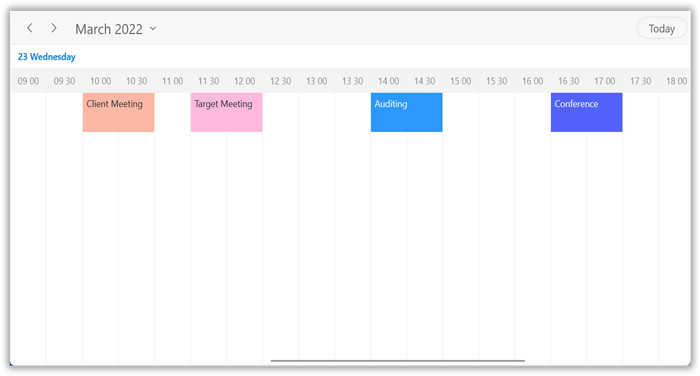
NOTE
- You can customize the appointment editor time format based on the scheduler time ruler format and culture.
- By default, the scheduler time ruler format is
h ttand the appointment editor time picker format ishh:mm tt.
View header
Customize the default appearance of view header in the timeline views by setting the ViewHeaderDateFormat, ViewHeaderHeight, ViewHeaderDayFormat, and ViewHeaderTemplate of TimelineViewSettings.
View header text formatting
Customize the date and day format of ViewHeader by using the ViewHeaderDateFormat and ViewHeaderDayFormat properties of TimelineViewSettings.
<scheduler:SfScheduler x:Name="Schedule" ViewType="TimelineWeek">
<scheduler:SfScheduler.TimelineViewSettings>
<scheduler:TimelineViewSettings
ViewHeaderDateFormat="dd-MMMM"/>
</scheduler:SfScheduler.TimelineViewSettings>
</scheduler:SfScheduler.TimelineViewSettings>
</scheduler:SfScheduler>this.Schedule.ViewType = SchedulerViewType.TimelineWeek;
this.Schedule.TimelineViewSettings.ViewHeaderDateFormat = "dd-MMMM";

View header height
Customize the height of the ViewHeader in timeline views by setting the ViewHeaderHeight property of TimelineViewSettings in SfScheduler.
<scheduler:SfScheduler x:Name="Schedule" ViewType="TimelineWeek">
<scheduler:SfScheduler.TimelineViewSettings>
<scheduler:TimelineViewSettings
ViewHeaderHeight="100"/>
</scheduler:SfScheduler.TimelineViewSettings>
</scheduler:SfScheduler>this.Schedule.ViewType = SchedulerViewType.TimelineWeek;
this.Schedule.TimelineViewSettings.ViewHeaderHeight = 100;
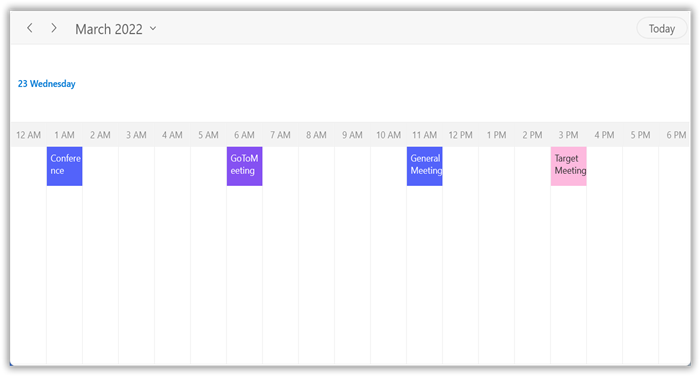
View header appearance customization
Customize the default appearance of view header by setting the ViewHeaderTemplate property of TimelineViewSettings in SfScheduler.
<Grid>
<Grid.Resources>
<DataTemplate x:Key="viewHeaderTemplate">
<StackPanel Background="Transparent"
Width="Auto"
VerticalAlignment="Center"
HorizontalAlignment="Stretch"
Orientation="Vertical">
<TextBlock
HorizontalAlignment="Left"
VerticalAlignment="Center"
Foreground="#8551F2"
FontFamily="Arial"
Text="{Binding DateText}"
FontSize="25"
TextTrimming="CharacterEllipsis"
TextWrapping="Wrap" />
<TextBlock
HorizontalAlignment="Left"
VerticalAlignment="Center"
Foreground="#8551F2"
FontFamily="Arial"
Text="{Binding DayText}"
FontSize="10"
TextTrimming="CharacterEllipsis"
TextWrapping="Wrap" />
</StackPanel>
</DataTemplate>
</Grid.Resources>
<scheduler:SfScheduler x:Name="Schedule" ViewType="TimelineWeek">
<scheduler:SfScheduler.TimelineViewSettings>
<scheduler:TimelineViewSettings
ViewHeaderTemplate="{StaticResource viewHeaderTemplate}" />
</scheduler:SfScheduler.TimelineViewSettings>
</scheduler:SfScheduler>
</Grid>Appointment height
Customize the height of the appointment in TimelineViews using the TimelineAppointmentHeight property of the TimelineViewSettings. By default, it’s value is fifty for the TimelineWeek, TimelineWorkWeek, and TimelineDay views and twenty for the TimelineMonth view.
<scheduler:SfScheduler x:Name="Schedule" ViewType="TimelineWeek">
<scheduler:SfScheduler.TimelineViewSettings>
<scheduler:TimelineViewSettings
TimelineAppointmentHeight="100">
</scheduler:TimelineViewSettings>
</scheduler:SfScheduler.TimelineViewSettings>
</scheduler:SfScheduler>this.Schedule.ViewType = SchedulerViewType.TimelineWeek;
this.Schedule.TimelineViewSettings.TimelineAppointmentHeight = 100;
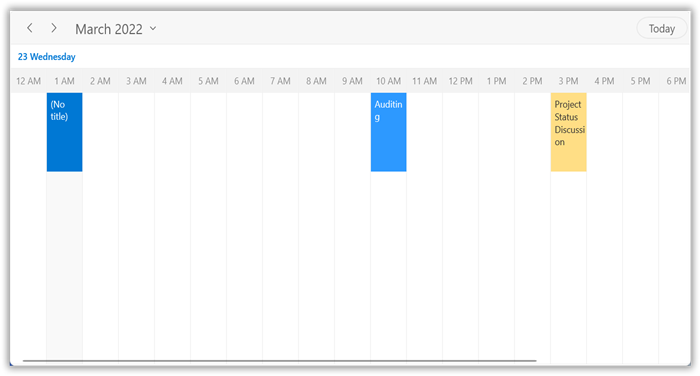
Cell bottom padding
To enhance interaction with a scheduler’s appointments, you can customize the spacing between appointments and the bottom border of their cells using the CellBottomPadding property of TimelineViewSettings in the SfScheduler.
<scheduler:SfScheduler x:Name="Schedule"
ViewType="TimelineWeek">
<scheduler:SfScheduler.TimelineViewSettings>
<scheduler:TimelineViewSettings CellBottomPadding="30" />
</scheduler:SfScheduler.TimelineViewSettings>
</scheduler:SfScheduler>this.Schedule.ViewType = SchedulerViewType.TimelineWeek;
this.Schedule.TimelineViewSettings.CellBottomPadding = 30;
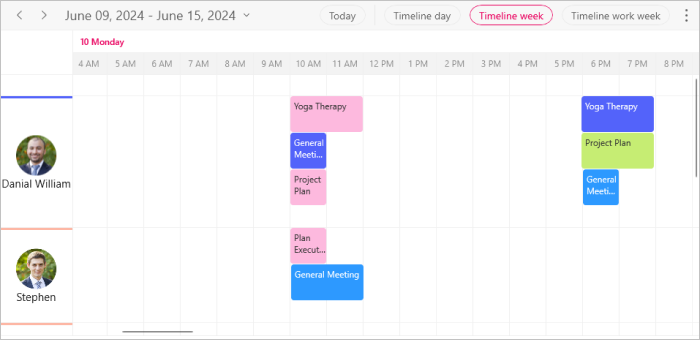
NOTE
- This customization will apply only when the scheduler has an appointment.